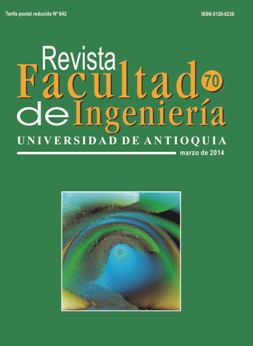Overlapped block-based compressive sensing imaging on mobile handset devices
DOI:
https://doi.org/10.17533/udea.redin.15284Keywords:
compressive sensing, sparse recovery, mobile handset devicesAbstract
Compressive Sensing (CS) is a new technique that simultaneously senses and compresses an image by taking a set of random projections from the underlying scene. An optimization algorithm is then used to recover the initial image. In practice, these optimization algorithms have restricted CS techniques to be implemented on high performance computational architectures, such as personal computers or graphical processing units (GPU) due the huge number of operations required for the image recovery. This work extends the application of CS to be implemented in an extremely limited memory and processing architecture such as a mobile device. Specifically, overlapped blocking-based algorithms are developed such that it is possible to reconstruct an image on a mobile device. An analysis of the energy consumption of the block-based CS algorithms is presented. The results show the required computational time for reconstruction and the image reconstruction quality for images of 128x128 and 256x256 pixels.
Downloads
References
D. Donoho. “Compressed sensing”. IEEE Trans. On Information Theory. Vol. 52. 2006. pp. 1289- 1306. DOI: https://doi.org/10.1109/TIT.2006.871582
T. Blumensath, M. Davies. “Gradient Pursuits”. IEEE Transactions on Signal Processing. Vol. 56. 2008. pp. 2370-2382. DOI: https://doi.org/10.1109/TSP.2007.916124
E. Candes, T. Tao. “Near optimal signal recovery from random projections: Universal encoding strategies?”. IEEE Trans. On Information Theory. Vol. 52. 2006. pp. 5406-5425. DOI: https://doi.org/10.1109/TIT.2006.885507
R. Calderban, S. Howard, S. Jafarpour. “Construction of a Large Class of Deterministic Sensing Matrices That Satisfy a Statistical Isometry Property”. IEEE Journal on Selected Topics in Signal Processing. Vol. 4. 2010. pp. 358-374. DOI: https://doi.org/10.1109/JSTSP.2010.2043161
L. Gan, T. Do, T. Tran. Fast compressive imaging using scrambled block Hadamard ensemble. Proceedings European Signal Processing Conference (EUSIPCO). Lausane, Switzerland. 2008. pp. 245.
T. Cai, G. Xu, J. Zhang, S. Member. “On Recovery of Sparse Signals Via l1 Minimization”. IEEE Transactions on Information Theory. Vol. 55. 2009. pp. 3388-3397. DOI: https://doi.org/10.1109/TIT.2009.2021377
S. Wright, R. Nowak, M. Figueiredo. “Sparse Reconstruction by Separable Approximation”. IEEE Transactions on Signal Processing. Vol. 57. 2008. pp. 2479-2493. DOI: https://doi.org/10.1109/TSP.2009.2016892
T. Blumensath, M. Davies. “Iterative hard thresholding for compressed sensing”. Applied and Computatational Harmonical Analysis. Vol. 27. 2009. pp. 265-274. DOI: https://doi.org/10.1016/j.acha.2009.04.002
J. Tropp. “Signal Recovery From Random Measurements Via Orthogonal Matching Pursuit”. IEEE Transactions on Information Theory. Vol. 53. 2007. pp. 4655-4666. DOI: https://doi.org/10.1109/TIT.2007.909108
M. Davenport, D. Takhar, J. Laska, T. Sun, K. Kelly, R. Baraniuk. “Single-pixel imaging via compressive sampling”. IEEE Signal Processing Magazine. Vol. 25. 2008. pp. 83-91. DOI: https://doi.org/10.1109/MSP.2007.914730
H. Arguello, G. Arce. “Code aperture optimization for spectrally agile compressive imaging”. Journal of the Optical Society of America (JOSA). Vol. 28. 2011. pp. 2400-2413. DOI: https://doi.org/10.1364/JOSAA.28.002400
H. Arguello, C. Correa, G. Arce. “Fast lapped reconstructions in compressive spectral imaging”. Journal Applied Optics. Vol. 52. 2013. pp. D32-D45. DOI: https://doi.org/10.1364/AO.52.000D32
M Balouchestani, K. Raahemifar, S. Krishnan. “Robust Wireless Sensor Networks with Compressing Sensing theory”. Springer Communication in Comp. and. Inf. Science. Vol. 293. 2012. pp. 608-619. DOI: https://doi.org/10.1007/978-3-642-30507-8_50
E. Correia, O. Postolache, P. Silva. “Implementation of compressed sensing in telecardiology sensor networks”. International journal of telemedicine and applications. Vol. 2010. pp. 1-12. DOI: https://doi.org/10.1155/2010/127639
K. Kanoun, H. Mamaghanian, A. David. A realtime compressed sensing based personal electrocardiogram monitoring system. Design, Automation & Test in Europe Conference (DATE). Grenoble, France. 2011. pp. 1-6. DOI: https://doi.org/10.1109/DATE.2011.5763140
R. Willett, R. Marcia, J. Nichols. “Compressed sensing for practical optical imaging systems: a tutorial”. SPIE Optical Engineering. Vol. 50. 2011. pp. 586. DOI: https://doi.org/10.1364/FIO.2011.FMM1
T. Blumensath. “Accelerated iterative hard thresholding”. IEEE Signal Processing Letters. Vol. 92. 2011. pp. 1-10. DOI: https://doi.org/10.1016/j.sigpro.2011.09.017
H. Arguello, G. Arce. Restricted Isometry Property in Coded Aperture Compressive Spectral Imaging. IEEE Statistical Signal Processing Workshop. Ann Arbor, USA. 2012. pp. 716-719. DOI: https://doi.org/10.1109/SSP.2012.6319803
I. Gutierrez, H. Arguello, K. Winbladh. Implementation of Imaging Compressive Sensing Algorithms on Mobile Handset Devices. International Conference on Broadband and Wireless Computing, Communications and Applications. Victoria, Canada. 2012. pp. 252- 259. DOI: https://doi.org/10.1109/BWCCA.2012.48
P. Sermwuthisarn, S. Auethavekiat and V. Patanavijit. A Fast Image Recovery Using Compressive Sensing Technique with Block Based Orthogonal Matching Pursuit. International Symposium on Intelligent Signal Processing and Communication Systems (ISPACS). Tokyu, Kanazawa, Japan. 2009. pp. 212-215. DOI: https://doi.org/10.1109/ISPACS.2009.5383863
L. Gan. Block Compressed Sensing of Natural Images. International Conference in Digital Signal Processing. Cardiff, UK. 2007. pp. 403-406. DOI: https://doi.org/10.1109/ICDSP.2007.4288604
Downloads
Published
How to Cite
Issue
Section
License
Copyright (c) 2018 Revista Facultad de Ingeniería

This work is licensed under a Creative Commons Attribution-NonCommercial-ShareAlike 4.0 International License.
Revista Facultad de Ingeniería, Universidad de Antioquia is licensed under the Creative Commons Attribution BY-NC-SA 4.0 license. https://creativecommons.org/licenses/by-nc-sa/4.0/deed.en
You are free to:
Share — copy and redistribute the material in any medium or format
Adapt — remix, transform, and build upon the material
Under the following terms:
Attribution — You must give appropriate credit, provide a link to the license, and indicate if changes were made. You may do so in any reasonable manner, but not in any way that suggests the licensor endorses you or your use.
NonCommercial — You may not use the material for commercial purposes.
ShareAlike — If you remix, transform, or build upon the material, you must distribute your contributions under the same license as the original.
The material published in the journal can be distributed, copied and exhibited by third parties if the respective credits are given to the journal. No commercial benefit can be obtained and derivative works must be under the same license terms as the original work.










 Twitter
Twitter